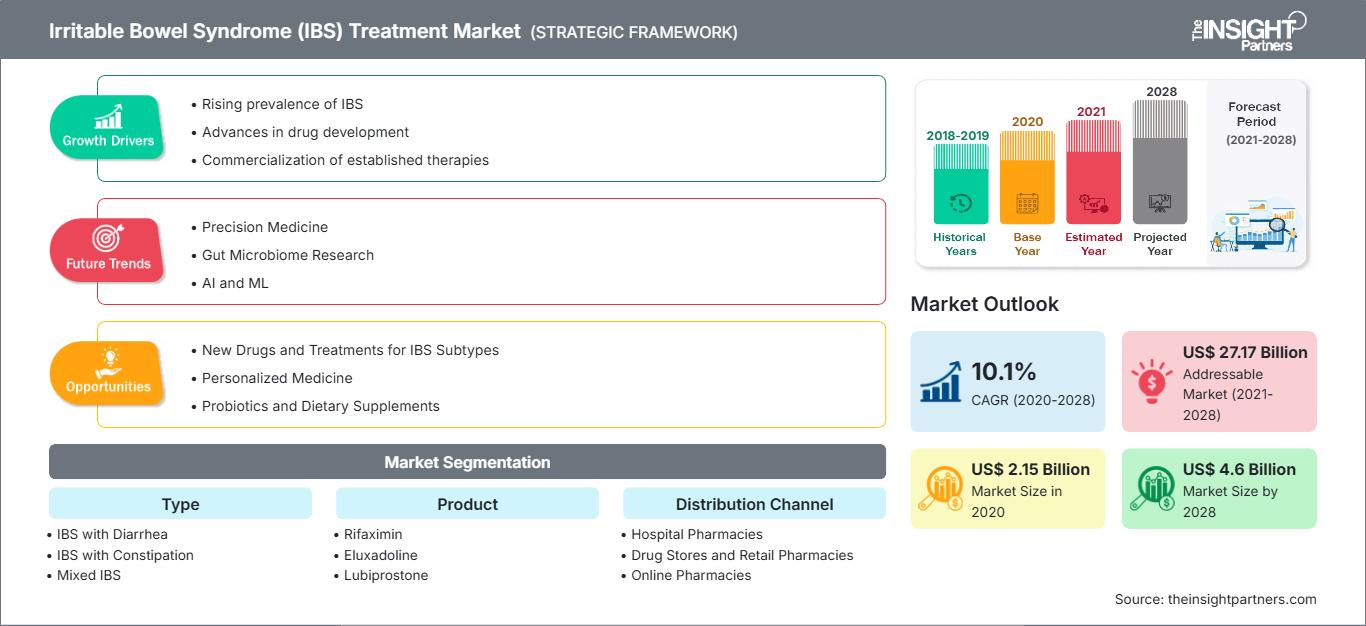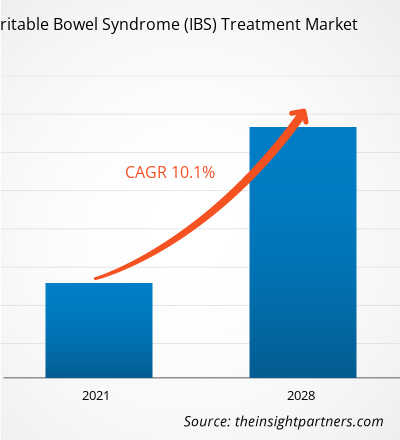Il mercato dei trattamenti per la sindrome dell'intestino irritabile (IBS) è stato valutato a 2.153,89 milioni di dollari nel 2020 e si prevede che raggiungerà i 4.600,30 milioni di dollari entro il 2028; si prevede una crescita a un CAGR del 10,1% dal 2021 al 2028.
Fattori principali come la crescente prevalenza delle malattie della sindrome dell'intestino irritabile e l'aumento delle attività di ricerca e sviluppo guidano la crescita del mercato. Tuttavia, la limitata disponibilità di prodotti e l'inefficacia del trattamento frenano la crescita del mercato. La sindrome dell'intestino irritabile (IBS) è una condizione cronica comune che colpisce l'organo addominale, l'intestino crasso. È anche nota come colon spastico, colite mucosa, colon irritabile e colite spastica. La condizione è molto diversa dalla malattia infiammatoria intestinale. Presenta sintomi come crampi, dolore addominale, gonfiore, gas e diarrea o stitichezza, o entrambi contemporaneamente. Se i sintomi sono lievi, possono essere gestiti modificando lo stress, lo stile di vita e la dieta. Al contrario, i sintomi gravi vengono trattati con farmaci e consulenza psicologica.
In Asia-Pacifico, sono state implementate numerose misure per contenere la diffusione del nuovo coronavirus che causa il COVID-19. Tali misure hanno interrotto le attività di molte aziende in vari settori, incluso quello sanitario. La quarantena del personale, le interruzioni della catena di approvvigionamento e la riduzione della domanda hanno generato gravi complicazioni per le aziende. Inoltre, si è registrato un calo significativo delle cure ospedaliere e ambulatoriali nelle catene ospedaliere private. Per alleviare i sistemi sanitari, molte cliniche stanno rinviando gli appuntamenti non critici. Questo scenario sta ostacolando la crescita del trattamento della sindrome dell'intestino irritabile (IBS).
Personalizza questo rapporto in base alle tue esigenze
Potrai personalizzare gratuitamente qualsiasi rapporto, comprese parti di questo rapporto, o analisi a livello di paese, pacchetto dati Excel, oltre a usufruire di grandi offerte e sconti per start-up e università
Mercato dei trattamenti per la sindrome dell'intestino irritabile (IBS): Approfondimenti strategici

-
Ottieni le principali tendenze chiave del mercato di questo rapporto.Questo campione GRATUITO includerà l'analisi dei dati, che vanno dalle tendenze di mercato alle stime e alle previsioni.
Approfondimenti di mercato
Aumento della prevalenza della sindrome dell'intestino irritabile e delle patologie associate
La sindrome dell'intestino irritabile è una patologia gastrointestinale cronica molto diffusa, causata da disturbi dell'alvo e dolore addominale. La malattia è anche nota come colon spastico, colon irritabile, colite mucosa e colite spastica. La sindrome dell'intestino irritabile si manifesta con sintomi quali dolore addominale, stitichezza, diarrea e crampi. I sistemi sanitari di tutte le regioni stanno assistendo a una crescita considerevole dell'incidenza della sindrome dell'intestino irritabile. I dati pubblicati dall'International Foundation for Gastrointestinal Disorders affermano che tra tutti i pazienti affetti da sindrome dell'intestino irritabile, circa il 40% soffre di sindrome dell'intestino irritabile lieve, circa il 35% di sindrome dell'intestino irritabile moderata e circa il 25% di sindrome dell'intestino irritabile grave. Molte persone non riconoscono i sintomi della sindrome dell'intestino irritabile.
Alcuni fattori come allergie alimentari, fasi evolutive di gastroenterite, movimenti sporadici del colon, composizione anomala della serotonina nel colon e celiachia lieve sono tra i fattori di rischio che possono causare la sindrome dell'intestino irritabile (IBS). Si prevede che questi fattori accelereranno il tasso di prevalenza della sindrome dell'intestino irritabile (IBS) in tutto il mondo. Ad esempio, secondo uno studio pubblicato su NCBI nel 2018, si stima che la sindrome dell'intestino irritabile colpisca circa il 10-16% della popolazione statunitense ogni anno. È probabile che una prevalenza così sbalorditiva della sindrome dell'intestino irritabile (IBS) aumenti il mercato dei trattamenti per la sindrome dell'intestino irritabile (IBS) durante il periodo di previsione.
Approfondimenti basati sulla tipologia di malattia
In base alla tipologia, il mercato dei trattamenti per la sindrome dell'intestino irritabile (IBS) è segmentato in IBS mista (IBS-M), IBS con diarrea (IBS-D) e IBS con stitichezza (IBS-C). Nel 2020, il segmento della sindrome dell'intestino irritabile mista (IBS-M) ha detenuto la quota maggiore del mercato. Inoltre, si prevede che lo stesso segmento registrerà il CAGR più elevato durante il periodo di previsione. Si prevede che la crescente prevalenza della sindrome dell'intestino irritabile tra donne e uomini stimolerà la domanda di farmaci in grado di trattare i sintomi combinati di stitichezza e diarrea. La prevalenza della sindrome dell'intestino irritabile è maggiore nella popolazione anziana. Pertanto, è probabile che la domanda di farmaci per il trattamento della sindrome dell'intestino irritabile mista cresca significativamente durante il periodo di previsione.
Approfondimenti basati sui prodotti
In base al prodotto, il mercato del trattamento della sindrome dell'intestino irritabile (IBS) è segmentato in rifaximina, eluxadolina, lubiprostone, linaclotide e altri. Il segmento del linaclotide ha detenuto la quota maggiore del mercato nel 2020. Inoltre, si stima che lo stesso segmento registrerà il CAGR più elevato sul mercato durante il periodo di previsione. La crescita del mercato per il segmento è attribuita a fattori quali l'aumento della produzione della versione generica del linaclotide e il crescente consolidamento del mercato per lo sviluppo e la commercializzazione del linaclotide per il trattamento della sindrome dell'intestino irritabile (IBS).
Approfondimenti basati sul canale di distribuzione
In base al canale di distribuzione, il mercato del trattamento della sindrome dell'intestino irritabile (IBS) è segmentato in farmacie ospedaliere, parafarmacie e farmacie al dettaglio, e farmacie online. Nel 2020, il segmento delle farmacie ospedaliere deteneva la quota di mercato maggiore. Tuttavia, si prevede che il segmento delle parafarmacie e delle farmacie al dettaglio registrerà il CAGR più elevato durante il periodo di previsione.
Le aziende che operano nel mercato del trattamento della sindrome dell'intestino irritabile (IBS) adottano una strategia di innovazione di prodotto per soddisfare le mutevoli esigenze dei clienti in tutto il mondo, il che consente loro anche di mantenere il proprio marchio sul mercato globale.
Approfondimenti regionali sul mercato del trattamento della sindrome dell'intestino irritabile (IBS)
Le tendenze regionali e i fattori che influenzano il mercato dei trattamenti per la sindrome dell'intestino irritabile (IBS) durante il periodo di previsione sono stati ampiamente spiegati dagli analisti di The Insight Partners. Questa sezione illustra anche i segmenti di mercato e la geografia dei trattamenti per la sindrome dell'intestino irritabile (IBS) in Nord America, Europa, Asia-Pacifico, Medio Oriente e Africa, America meridionale e centrale.
Ambito del rapporto di mercato sul trattamento della sindrome dell'intestino irritabile (IBS)
| Attributo del rapporto | Dettagli |
|---|---|
| Dimensioni del mercato in 2020 | US$ 2.15 Billion |
| Dimensioni del mercato per 2028 | US$ 4.6 Billion |
| CAGR globale (2020 - 2028) | 10.1% |
| Dati storici | 2018-2019 |
| Periodo di previsione | 2021-2028 |
| Segmenti coperti |
By Tipo
|
| Regioni e paesi coperti |
Nord America
|
| Leader di mercato e profili aziendali chiave |
|
Densità degli operatori del mercato del trattamento della sindrome dell'intestino irritabile (IBS): comprendere il suo impatto sulle dinamiche aziendali
Il mercato dei trattamenti per la sindrome dell'intestino irritabile (IBS) è in rapida crescita, trainato dalla crescente domanda da parte degli utenti finali, dovuta a fattori quali l'evoluzione delle preferenze dei consumatori, i progressi tecnologici e una maggiore consapevolezza dei benefici dei prodotti. Con l'aumento della domanda, le aziende stanno ampliando la propria offerta, innovando per soddisfare le esigenze dei consumatori e sfruttando le tendenze emergenti, alimentando ulteriormente la crescita del mercato.

- Ottieni il Mercato dei trattamenti per la sindrome dell'intestino irritabile (IBS) Panoramica dei principali attori chiave
Mercato del trattamento della sindrome dell'intestino irritabile (IBS) - per tipo
- IBS con diarrea (IBS-D)
- IBS con stitichezza (IBS-C)
- IBS mista (IBS-M)
Mercato del trattamento della sindrome dell'intestino irritabile (IBS) - per prodotto
- Rifaximina
- Eluxadolina
- Linaclotide
- Lubiprostone
- Altri
Mercato del trattamento della sindrome dell'intestino irritabile (IBS) - per tipo per canale di distribuzione
- Ospedali Farmacie
- Farmacie e farmacie al dettaglio
- Farmacie online
Mercato del trattamento della sindrome dell'intestino irritabile (IBS) - per area geografica
-
America del Nord
- Stati Uniti
- Canada
- Messico
-
Europa
- Francia
- Germania
- Italia
- Regno Unito
- Spagna
- Resto di Europa
-
Asia Pacifico (APAC)
- Cina
- India
- Corea del Sud
- Giappone
- Australia
- Resto dell'APAC
-
Medio Oriente e Africa (MEA)
- Sudafrica
- Arabia Saudita Arabia
- Emirati Arabi Uniti
- Resto del MEA
-
Sud e America Centrale (SCAM)
- Brasile
- Argentina
- Resto di SCAM
Profili aziendali
- Ironwood Pharmaceuticals, Inc.
- AbbVie.
- Sebela Pharmaceuticals, Inc.
- Takeda Pharmaceutical Company Limited
- Alfasigma SpA
- Astellas Pharma Inc.
- AstraZeneca
- Synthetic Biologics, Inc.
- Bausch + Lomb Incorporated
- Lannett Company Inc
- Analisi storica (2 anni), anno base, previsione (7 anni) con CAGR
- Analisi PEST e SWOT
- Valore/volume delle dimensioni del mercato - Globale, Regionale, Nazionale
- Industria e panorama competitivo
- Set di dati Excel
Report recenti
Testimonianze
Motivo dell'acquisto
- Processo decisionale informato
- Comprensione delle dinamiche di mercato
- Analisi competitiva
- Analisi dei clienti
- Previsioni di mercato
- Mitigazione del rischio
- Pianificazione strategica
- Giustificazione degli investimenti
- Identificazione dei mercati emergenti
- Miglioramento delle strategie di marketing
- Aumento dell'efficienza operativa
- Allineamento alle tendenze normative






















 Ottieni un campione gratuito per - Mercato dei trattamenti per la sindrome dell'intestino irritabile (IBS)
Ottieni un campione gratuito per - Mercato dei trattamenti per la sindrome dell'intestino irritabile (IBS)